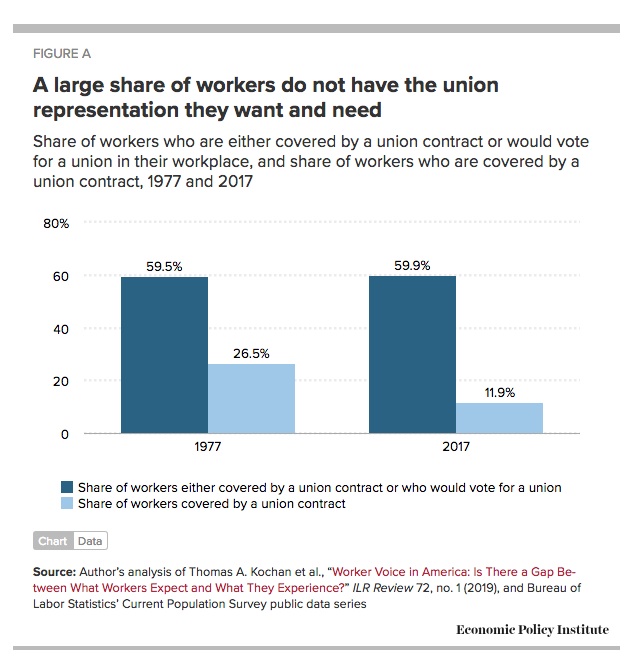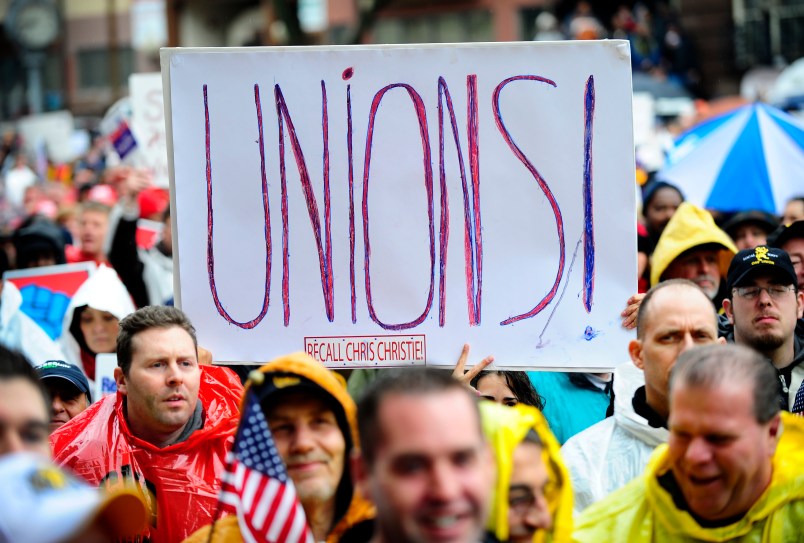This article is part of TPM Cafe, TPM’s home for opinion and news analysis. It first appeared at the Economic Policy Institute, and was reposted with permission of the authors.
A huge swath of U.S. workers do not have the union representation and voice at work that they want and need. The share of workers covered by a collective bargaining agreement dropped from 27.0% to 11.7% between 1979 and 2018, meaning the union coverage rate is now less than half where it was 40 years ago.
Are today’s workers just less interested in being in a union than workers of prior decades? Not in the least. Figure A shows the share of workers who are either covered by a union contract or report they would vote for a union if a union election were held at their workplace—60% in both 1977 and 2017 (we use these years here, instead of 1979 and 2018, due to limited data availability). Given the decline in union membership during those same years (also shown in Figure A), that share is now five times as high as the actual share of workers who are covered by a union contract.

Why? Impeding union representation has been a primary goal of corporate interests in recent decades, and these interests have convinced conservative policymakers to attack collective bargaining through legislation, executive rulemaking, and the courts. Meanwhile, policymakers claiming to care about the economic struggles of typical Americans have too often turned a blind eye to these attacks. But if workers are not able to effectively organize into unions, broadly shared prosperity that extends to most working people has virtually no chance.
Collective bargaining benefits workers
It’s no surprise that workers want unions. When workers are able to come together, form a union, and collectively bargain, their wages, benefits, and working conditions improve. On average, a worker covered by a union contract earns 13.2% more than a peer with similar education, occupation, and experience in a nonunionized workplace in the same sector.
Union workers are more likely to have employer-sponsored health insurance, and their employers tend to contribute more toward those plans. They are also more likely to have paid vacation and sick leave, more input into the number of hours they work, and more predictable schedules. Union employers are more likely to offer retirement plans and to contribute more toward those plans than comparable nonunion employers.
Unions also help shrink racial wage gaps. For example, black workers are more likely than white workers to be represented by a union, and black workers who are in unions get a larger boost to wages from being in a union than white workers do (i.e., the “union wage premium” is larger for black workers than for white workers). These two facts together mean that today’s unions help narrow the black–white wage gap—and research shows that this phenomenon isn’t new. Starting in the mid-1940s, black workers began to be more likely to be in unions and to have a larger union premium than white workers. This means that the decline of unionization has played a significant role in the expansion of the black–white wage gap.
Private employment in almost every state in the U.S. is “at will,” with employers free to dismiss any worker at any time, with no warning, for almost any reason (except for the few reasons specified by law, e.g., on account of race, religion, age, sex, national origin, pregnancy, or disability). Union contracts, on the other hand, provide workers due process protections. Unions also create safer workplaces; because union workers are protected by their unions from repercussions for reporting safety issues, they are more likely to report safety concerns, and this increased reporting can lead to a reduction in work hazards.
Furthermore, the benefits of collective bargaining extend beyond those employees who are represented by a union. Where unions are strong, they effectively set broader standards that nonunion employers must meet in order to attract and retain the workers they need and to avoid facing an organizing drive. The combination of the direct effect of unions on union members and this “spillover” effect to nonunion workers means unions are crucial in fostering a vibrant middle class and reducing income inequality.
The decline of collective bargaining is the direct result of employers’ anti-union activities
The decline in collective bargaining in recent decades has distinctly not been a “natural” phenomenon, as the public commentators and policymakers who prioritize the interests of corporate executives and shareholders over those of working people would like you to believe. Quite the contrary. Fierce corporate opposition has suppressed workers’ freedom to form unions and bargain collectively. Intense and aggressive anti-union campaigns—once confined to the most anti-union employers—have become widespread; it is now typical, when workers seek to organize, for their employers to hire union avoidance consultants to orchestrate fierce anti-union campaigns.
And though the National Labor Relations Act (NLRA) makes it illegal for employers to intimidate, coerce, or fire workers in retaliation for participating in union-organizing campaigns, the penalties are insufficient to provide a serious economic disincentive for such behavior (there are no punitive damages or criminal charges under the NLRA; penalties may consist of being required to post a notice or reinstate illegally fired workers). This means that many illegal tactics can be actively pursued; for example, employers often threaten to close the worksite, cut union activists’ hours or pay, or report workers to immigration enforcement authorities if employees unionize. More than one in seven union organizers and activists are illegally fired while trying to organize unions at their place of work.
In the face of these attacks on collective bargaining, policymakers have egregiously failed to update labor laws to rebalance the system. In fact, in many cases policy is moving backward; 27 states have passed so-called right-to-work laws, which are intended to undermine union finances by making it illegal for unions to require nonunion members of a collective bargaining unit (who don’t pay union dues) to pay “fair share fees”—fees that cover only the basic costs of representing employees in the workplace. And the Supreme Court decision in Janus v. AFSCME—a case financed by a small group of foundations with ties to the largest and most powerful corporate lobbies—made “right-to-work” the law of the land for all public-sector unions.
Conclusion: We need to protect workers’ rights to organize and bargain collectively
Many of the reasons workers want to be in unions—e.g., to improve their wages, benefits, and working conditions—are, of course, precisely the reasons unions are opposed so fiercely by corporate interests. Figure B provides an instructive raw comparison, showing that as union coverage has eroded, the share of total income in the economy that gets funneled to the rich has skyrocketed. More rigorous research shows that de-unionization accounts for a sizable share of the growth in inequality between typical workers and workers at the high end of the wage distribution in recent decades—on the order of 13–20% for women and 33–37% for men. Efforts to erode worker power have paid off handsomely for the small sliver of people on the winning end of rising inequality.

The large gap between the share of workers who want a union and the share of workers who are in a union underscores that our system of labor laws is not working. Fundamental reform is required to rebuild worker power and guarantee all workers the right to come together and have a voice in their workplace. Efforts are underway, including legislation like the Protecting the Right to Organize Act and the Public Service Freedom to Negotiate Act, and innovative projects focused on the reconstruction of labor law. Until meaningful policy changes are made that take worker power seriously and restore a fair balance of power between workers and employers, our economy will continue to leave behind most of the workers in it.
Endnotes
1. Bureau of Labor Statistics, “Union Members—2018” (news release), January 18, 2019; Economic Policy Institute, State of Working America Data Library, “Union Coverage” (data table), last updated February 2017.
2. Unless otherwise noted, information in this section is from Bivens et al., How Today’s Unions Help Working People: Giving Workers the Power to Improve Their Jobs and Unrig the Economy, Economic Policy Institute, August 2017.
3. Henry S. Farber et al., “Unions and Inequality over the Twentieth Century; New Evidence from Survey Data,” National Bureau of Economic Research Working Paper no. 24587, May 2018.
4. Valerie Wilson and William M. Rodgers III, Black–White Wage Gaps Expand with Rising Wage Inequality, Economic Policy Institute, September 2016.
5. John Schmitt and Ben Zipperer, Dropping the Ax: Illegal Firings During Union Election Campaigns, 1951–2007, Center for Economic and Policy Research, March 2009.
6. Celine McNicholas, Zane Mokhiber, and Marni von Wilpert, Janus and Fair Share Fees: The Organizations Financing the Attack on Unions’ Ability to Represent Workers, Economic Policy Institute, February 2018.
7. The estimates of 13% for women and 37% for men are from author’s analysis of data from Nicole M. Fortin, Thomas Lemieux, and Neil Lloyd, “Labor Market Institutions and the Distribution of Wages: The Role of Spillover Effects,” Vancouver School of Economics, University of British Columbia, working paper, February 2019. The estimates of 20% for women and 33% for men are from Bruce Western and Jake Rosenfeld, “Unions, Norms, and the Rise in U.S. Wage Inequality,” American Sociological Review 76, no. 4 (August 2011): 513–537. Western and Rosenfeld estimate that “deunionization explains a fifth of the inequality increase for women and a third for men.”
8. Celine McNicholas and Lynn Rhinehart, “The PRO Act: Giving Workers More Bargaining Power on the Job,” Working Economics Blog (Economic Policy Institute), May 2, 2019; Celine McNicholas and Margaret Poydock, “The Public Service Freedom to Negotiate Act Provides Public-Sector Workers the Right to Join in Union and Collectively Bargain,” Working Economics Blog (Economic Policy Institute), June 26, 2019; Harvard University Labor and Worklife Program, “Rebalancing Economic and Political Power: A Clean Slate for the Future of Labor Law” (program web page), accessed August 5, 2019.
Heidi Shierholz leads the Economic Policy Institute’s policy team, where she monitors federal wage and employment policies. Her work has been cited by several media outlets, including ABC, CBS, NBC, CNN, NPR, The New York Times, The Washington Post, and HuffPost.







And people idolize pro athletes (who are unionized) as gods, all while trashing unions for themselves.
Truly, the Right Wing has become the Main Opinion for too many of us.
I’m not trying to bash the union idea, but how does a union successfully operate in a company where voluntary job tenure is relatively short? How would a union keep its membership united during a work stoppage? What would be the benefits of staying with the same employer?
When all the foreign car manufacturers moved to the US, guess where they moved? The southern states where there are not unions and they can get workers for cheap.
If fast food places, Walmart, Home Depot and Amazon had to unionize and pay their employees reasonable wages, none of these places would be the darlings of America.
You are certainly NOT trying to bash the union idea. Rather, you are responding to realities in the workplace. All of which would have to be dealt with, creatively.
I do believe, however, that there are ways through this problem.
The business roundtable recently recommended treating workers with “dignity”. While one wonders why the BRT needed to announce this as if it were a radical governance concept, I’ll believe it when there is tangible evidence of their supporting their workers’ efforts to organize and “dignity” reflected in contract terms. If we really want to address inequality, we need to support workers’ organizing and the unions to equilibrate the power dynamic of management v workers.
“Right to work laws” are an affront to that objective for starters.